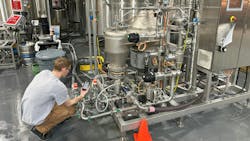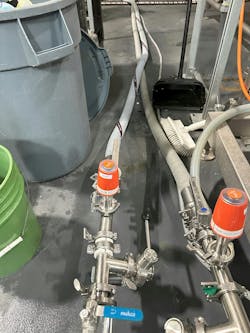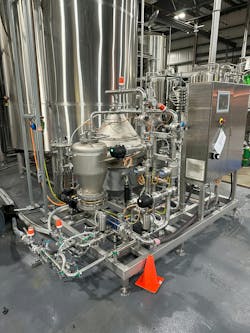Saving every drop: The role sensors play in reducing water waste in beer production
Sensor technology is vital in helping breweries optimize water consumption and minimize waste. Water is a primary ingredient in beer and essential at every stage of the brewing process. It demands efficient use to ensure sustainability and maintain the highest quality of the final product.
The amount of water wasted or used inefficiently in brewing can vary significantly depending on a brewery's size, automation technology and water management practices. Typically, even a well-operated brewhouse uses about seven gallons of water to produce just one gallon of beer. Sensors, with their real-time data and automation capabilities, empower breweries to monitor, control and precisely adjust water-related processes, significantly enhancing efficiency.
Automation conserves water by closely monitoring flow and usage, particularly when water is recycled and reintegrated into different stages of the brewing process. Sensors track the volume of water consumed throughout each stage, providing real-time data that help brewers pinpoint areas of excessive use and implement corrective actions to reduce waste.
Aggregate data from multiple sensors offer valuable insights into overall water usage patterns, identifying inefficiencies and highlighting areas for improvement. Additionally, this data helps predict equipment failures or maintenance needs, which reduces water waste caused by unexpected downtime or inefficient operations.
Automation provides operators with peace of mind
At Lord Hobo Brewing Company in Woburn, Massachusetts, multiple intelligent sensors are used to streamline operations, generate actionable data and continuously monitor critical equipment around the clock.
Brewmaster Keith Gabbett emphasizes that the greatest benefit of sensor technology is the confidence and redundancy it brings. “We can feel comfortable knowing our brewery and utilities are functioning as they should,” Gabbett said. “When something goes wrong, we receive instant notifications, allowing us to react quickly and minimize downtime.”
John Irwin, who has managed the maintenance at Lord Hobo for seven years, explains that peace of mind and how it allows him to proactively schedule downtime — something that is crucial for keeping his machines running.
“I’m the maintenance department,” Irwin says. “If it breaks, I fix it. If it is new, I install it. My job is to keep everything running smoothly. Sensor technology gives us eyes on the equipment at all times, which makes my job so much easier.”
How sensor technology optimizes the CIP process
Clean-in-place (CIP) is one of the most critical safety processes in beer brewing and is essential for sanitizing equipment without disassembly or relocation. Since CIP is applied across all brewery equipment, its efficiency plays a key role in managing water usage effectively.
By using conductivity and water quality sensors, brewers can precisely monitor chemical levels in cleaning water throughout the CIP process. This transparency enables them to determine when the final rinse cycle is complete, leading to reduced chemical use and minimized clean water waste.
Modern technologies that enhance CIP processes are now accessible to breweries of all sizes. Larger breweries often invest in fully automated systems that are permanently piped to each vessel or integrated into mobile CIP skids. These advanced systems automatically dose the correct amount of chemicals, control the wash and rinse cycles, and utilize data from conductivity and temperature sensors to ensure the final rinse water is clean before stopping the process.
Smaller breweries, often constrained by budget limitations, typically rely on semi-manual systems. These setups include a clean water source, a cart mounted transfer pump, caustic or acidic chemicals, and an operator to manage the entire process.
Depending on what is being cleaned and the brewery’s standard operating procedures, different chemicals are recirculated through the equipment at specific temperatures for a minimum amount of time. Afterward, the wastewater is drained, and fresh water is pumped in to rinse out any remaining chemical residue. The objective is to thoroughly clean the equipment as quickly as possible, minimizing chemicals and water, while ensuring no residue is left before production resumes.
Manual processes can be inefficient, unsafe, and wasteful — requiring significant time and manpower. Sensor technology offers an affordable alternative, automating the process to save time, reduce costs and enhance the consistency and quality of the beer.
By integrating a conductivity sensor into its CIP process, Lord Hobo Brewing immediately gained the ability to monitor operations in real time. The sensor provides clear visual feedback — blinking red when chemicals are present and green when the water is clean. Historical data allows Lord Hobo to analyze the conductivity and temperature of CIP cycles, offering insights into the process duration. This simplification enabled operators to multitask with confidence, knowing that the equipment was thoroughly sanitized before valuable product was added to the tanks.
“Automation has significantly reduced the amount of water we use for rinsing tanks after CIP,” says Gabbett. “The sensor clearly indicates when the tank is fully rinsed of caustic or acid, and because it is visible from across the cellar, we can quickly shut off the water. The ease of installation and immediate impact on water usage made it a valuable addition from day one.”
When integrated with valves and controllers, sensors enable systems to automatically adjust water flow based on real-time data, ensuring precise water usage at every brewing step. These sensors also monitor water levels in tanks and other equipment, preventing overflows and reducing unnecessary water consumption.
Pressure sensors maintain optimal levels in pipes and tanks, preventing leaks and overflows that contribute to significant water waste. Additionally, dissolved oxygen sensors monitor water quality, ensuring that reused water meets safety and quality standards, thereby reducing the need for excessive fresh water.
Water-saving benefits of brewery automation
A small brewery with a 10-barrel system (producing 310 gallons of beer) can waste more than 1,500 gallons of water in a single brew day. For larger systems, water waste can easily reach tens of thousands of gallons per batch.
Reduced water consumption lowers both water and wastewater costs while making a significant environmental impact. Minimizing water waste aligns with sustainable brewing best practices. Real-time monitoring and automation further streamline operations, saving both time and resources.
Reducing water waste remains a significant challenge in the beer industry, but many breweries are actively adopting sustainable practices to improve efficiency. Sensor technology plays a crucial role in this effort, empowering breweries to make data-driven decisions and ensuring that every drop of water is used effectively throughout the brewing process.
About the Author
Aaron Ganick
Founder and CEO of Preddio Technologies, the parent company of BrewOps
Aaron Ganick is a serial technology entrepreneur and the founder and CEO of Preddio Technologies, the parent company of BrewOps. Aaron holds a degree in electrical engineering from Boston University and has authored dozens of granted patents in the fields of optical networking, telecommunications, and automation systems. He can be reached at [email protected]. For more information on BrewOps, the fast and easy-to-install brewery automation platform, visit www.brewops.com.


